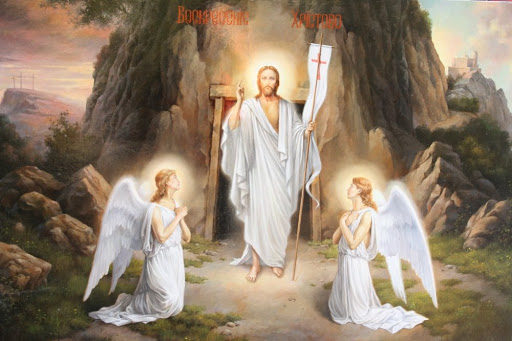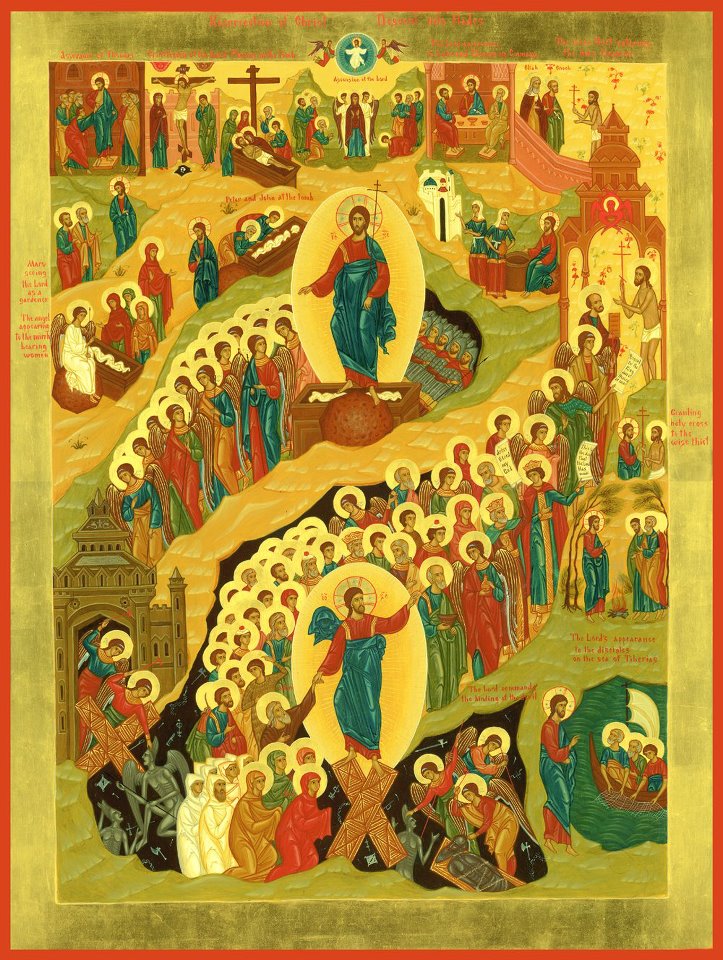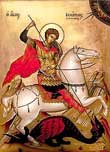St.George Russian Orthodox Church
Easter Sunday: The Holy Pascha 2020

Since at the present moment Orthodox people are significantly limited in visiting churches because of the threat of the spread of coronavirus infection, our website contains liturgical texts of the Easter Sunday: The Holy Pascha, adapted for home use:
- Holy Saturday Midnight office;
- Paschal Hours;
- Paschal Matins;
- Paschal Typica;
You can download liturgical texts for the Easter Sunday: The Holy Pascha in PDF format below.
A little before midnight on the Blessed Sabbath the Nocturne service is chanted. The celebrant goes to the tomb and removes the winding-sheet. He carries it through the royal doors and places it on the altar table where it remains for forty days until the day of Ascension.
At midnight the Easter procession begins. The people leave the church building singing:
The angels in heaven, O Christ our Savior, sing of Thy resurrection. Make us on earth also worthy to hymn Thee with a pure heart.

The procession circles the church building and returns to the closed doors of the front of the church. This procession of the Christians on Easter night recalls the original baptismal procession from the darkness and death of this world to the light and the life of the Kingdom of God. It is the procession of the holy passover, from death unto life, from earth unto heaven, from this age to the age to come which will never end.
Before the closed doors of the church building, the resurrection of Christ is announced. Sometimes the Gospel is read which tells of the empty tomb. The celebrant intones the blessing to the “holy, consubstantial, life-creating and undivided Trinity.” The Easter troparion is sung for the first time, together with the verses of Psalm 68 which will begin all of the Church services during the Easter season.
Let God arise, let his enemies be scattered; let those who hate him flee from before his face!
Christ is risen from the dead, trampling down death by death, and upon those in the tombs bestowing life (Troparion).
This is the day which the Lord has made, let us rejoice and be glad in it!
The people re-enter the church building and continue the service of Easter Matins which is entirely sung.

The canon hymns of Christ’s resurrection, ascribed to Saint John of Damascus, are chanted with the troparion of the feast as the constantly recurring refrain. The building is decorated with flowers and lights. The vestments are the bright robes of the resurrection. The Easter icon stands in the center of the church showing Christ destroying the gates of hell and freeing Adam and Eve from the captivity of death. It is the image of the Victor “trampling down death by his own death.” There is the continual singing and censing of the icons and the people, with the constant proclamation of the celebrant: Christ is risen! The faithful continually respond: Indeed He is risen!
It is the day of resurrection ! Let us be illumined for the feast! Pascha! The Pascha of the Lord! From death unto life, and from earth unto heaven has Christ our God led us! Singing the song of victory: Christ is risen from the dead! (First Ode of the Easter Canon).
Following the canon, the paschal verses are sung, and at the conclusion of the Easter Matins, the Easter Hours are also sung. In general, nothing is simply read in the Church services of Easter: everything is fully sung with the joyful melodies of the feast.
At the end of the Hours, before the Divine Liturgy, the celebrant solemnly proclaims the famous Paschal Sermon of Saint John Chrysostom. This sermon is an invitation to all of the faithful to forget their sins and to join fully in the feast of the resurrection of Christ. Taken literally, the sermon is the formal invitation offered to all members of the Church to come and to receive Holy Communion, partaking of Christ, the Passover Lamb, whose table is now being set in the midst of the Church. In some parishes the sermon is literally obeyed, and all of the faithful receive the eucharistic gifts of the Passover Supper of Easter night.
The Easter Divine Liturgy begins immediately with the singing once more of the festal troparion with the verses of Psalm 68. Special psalm verses also comprise the antiphons of the liturgy, through which the faithful praise and glorify the salvation of God:
Make a joyful noise to the Lord, all the earth! Sing of his name, give glory to His praise.
Let all the earth worship Thee and praise Thee! Let it praise Thy name, O most High!
That we may know Thy way upon the earth and Thy salvation among all nations.
Let the people thank Thee, O God! Let all the people give thanks to Thee.
The troparion is repeated over and over again. The baptismal line from Galatians replaces the Thrice-Holy Hymn. The epistle reading is the first nine verses of the Book of Acts. The gospel reading is the first seventeen verses of the Gospel of Saint John. The proclamation of the Word of God takes the faithful back again to the beginning, and announces God’s creation and re-creation of the world through the living Word of God, his Son Jesus Christ.
In the beginning was the Word and the Word was with God and the Word was God . . . all things were made through him . . . In Him was life and the life was the light of men. . . .
And the Word became flesh and dwelt among us full of grace and truth . . . we have beheld His glory, glory of the only-begotten Son of the Father, and from His fullness have we all received grace upon grace (Jn 1.1–17).
The Liturgy of Saint John Chrysostom continues, crowned in holy communion with the Passover Lamb at his banquet table in God’s Kingdom. Again and again the troparion of the Resurrection is sung while the faithful partake of Him “Who was dead and is alive again” (Rev 2.8).
In the Orthodox Church the feast of Easter is officially called Pascha, the word which means the Passover. It is the new Passover of the new and everlasting covenant foretold by the prophets of old. It is the eternal Passover from death to life and from earth to heaven. It is the Day of the Lord proclaimed by God’s holy prophets, “the day which the Lord has made” for His judgment over all creation, the day of His final and everlasting victory. It is the Day of the Kingdom of God, the day “which has no night” for “its light is the Lamb” (Rev 21.22–25).
The celebration of Easter in the Orthodox Church, therefore, is once again not merely an historical reenactment of the event of Christ’s Resurrection as narrated in the gospels. It is not a dramatic representation of the first Easter morning. There is no “sunrise service” since the Easter Matins and the Divine Liturgy are celebrated together in the first dark hours of the first day of the week in order to give men the experience of the “new creation” of the world, and to allow them to enter mystically into the New Jerusalem which shines eternally with the glorious light of Christ, overcoming the perpetual night of evil and destroying the darkness of this mortal and sinful world:
Shine! Shine! O New Jerusalem! The glory of the Lord has shone upon you! Exult and be glad O Zion! Be radiant O Pure Theotokos, in the Resurrection of your Son!
This is one of the main Easter hymns in the Orthodox Church. It is inspired by Isaiah’s prophecy and the final chapters of the Book of Revelation, for it is exactly tile New Creation, the New Jerusalem, the Heavenly City, the Kingdom of God, the Day of the Lord, the Marriage Feast of the Lamb with His Bride which is celebrated and realized and experienced in the Holy Spirit on the Holy Night of Easter in the Orthodox Church.
www.oca.org
Attachments